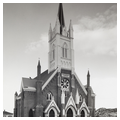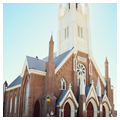Virginia City's strong Irish community built St. Mary in the Mountains as the largest and most ornate church in the Comstock. During the Great Fire of 1875, John Mackay convinced Father Patrick Manogue to allow the church to be blown up as a means of slowing the fire's
You are here
St. Mary in the Mountains Roman Catholic Church
1862, 1876–1877. Southeast corner of S. E and Taylor sts.
If SAH Archipedia has been useful to you, please consider supporting it.
SAH Archipedia tells the story of the United States through its buildings, landscapes, and cities. This freely available resource empowers the public with authoritative knowledge that deepens their understanding and appreciation of the built environment. But the Society of Architectural Historians, which created SAH Archipedia with University of Virginia Press, needs your support to maintain the high-caliber research, writing, photography, cartography, editing, design, and programming that make SAH Archipedia a trusted online resource available to all who value the history of place, heritage tourism, and learning.













